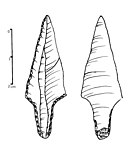Portal:Poland
Welcome to the Poland Portal — Witaj w Portalu o Polsce
Cityscape of Kraków, Poland's former capital

 constitutional crisis and democratic backsliding since 2015.
constitutional crisis and democratic backsliding since 2015.
From Polish history –
The
Homo sapiens. Stone Age cultures ranged from early human groups with primitive tools to advanced agricultural societies, which used sophisticated stone tools, built fortified settlements and developed copper metallurgy. As elsewhere in Europe, the Stone Age human cultures went through the stages known as the Paleolithic, Mesolithic and Neolithic, each bringing new refinements of the stone tool making techniques. The Paleolithic human activities were intermittent because of the recurring periods of glaciation. A general climate warming and the resulting increase in ecologic diversity was characteristic of the Mesolithic (9,000-8,000 BCE). The Neolithic brought the first settled agricultural communities whose founders migrated from the Danube River area starting ca. 5,500 BCE. Later the native post-Mesolithic populations also adopted and further developed the agricultural way of life (4,400–2,000 BCE). (Full article...
)
Selected image –

Credit: Krzysztof Mizera
Prayer of Saint Adalbert, one of 18 scenes in bas-relief, telling the story of Adalbert's life and martyrdom, that decorate the Romanesque bronze Gniezno Doors, the main entrance to the Gniezno Cathedral, which houses relics of the saint. Adalbert (Vojtěch) was a bishop of Prague and a missionary to Hungary, Poland, and Prussia where he was slain in AD 997.
Did you know –
- ... that Magdalena Fularczyk (pictured) was part of the first female Polish rowing team to win a world championship gold in an Olympic boat class?
- ... that during the Holocaust in German-occupied Poland, the Polish nine-member Król family rescued the Jewish six-member Steinlauf family from the Nowy Sącz Ghetto despite the risk of death penalty?
- ... that two Polish nuns harbouring Jewish fugitives who escaped from the Słonim Ghetto were beatified by Pope John Paul II among the 108 Martyrs of World War II?
- ... that the 2015 Polish horror film The Lure is a reimagining of The Little Mermaid set in the 1980s Poland?
- ... that Poland is creating a 35,000-strong volunteer military force designed to counter hybrid warfare?
You can help!
Selected biography –
Auschwitz Concentration Camp. While there, he organized inmate resistance, and as early as 1940, informed the Western Allies of Nazi Germany's Auschwitz atrocities. He escaped from the camp in 1943 and took part in the Warsaw Uprising. Pilecki was executed in 1948 by communist authorities. Until 1989, information on his exploits and fate was suppressed by the Polish the communist regime. (Full article...
)
Selected location –
Zagłębie Dąbrowskie). Thanks to rich natural resources and a strategic location on the border of Russian, German and Austro-Hungarian empires, the village of Sosnowiec grew rapidly during the 19th century and was granted a town charter in 1902. Another period of vigorous development occurred in the 1970s, when Edward Gierek, a native of Sosnowiec, served as first secretary of the communist Polish United Workers' Party. On the city's centennial in 2002, the city center (pictured) was thoroughly rebuilt and modernized. Some coal mines and steel mills continue to operate in Sosnowiec as trade and service sectors are expanding. (Full article...
)
Poland now
Recent events
- On 8 April, local elections (map of voivodeship-level results shown) were held throughout Poland, with run-off votes in some municipalities held on 21 April.
- On 9 January, police entered the Law and Justiceparty) and his former deputy, both of whom had been sentenced to two year's jail for abuse of power.
- On 9 January, Tadeusz Isakowicz-Zaleski, an Armenian and Roman Catholic priest, and former anti-Communist dissident, died at the age of 67.
- On 13 December, Donald Tusk of the Civic Coalition was sworn in for his third nonconsecutive term as Prime Minister of Poland.
Upcoming
- European Parliament election on 9 June
Ongoing
Constitutional crisis • Belarus–EU border crisis • Ukrainian refugee crisis
Holidays and observances in April 2024
(statutory public holidays in bold)
- April Fool's Day, 1 April
- Easter Monday, 1 April
Subcategories
Topics
People
|
|
Related portals
| Belarus | Czech Republic | Germany | Lithuania | Russia | Slovakia | Ukraine |
| Europe | Catholicism
|
Communism | European Union |
Associated Wikimedia
The following Wikimedia Foundation sister projects provide more on this subject:
-
Commons
Free media repository -
Wikibooks
Free textbooks and manuals -
Wikidata
Free knowledge base -
Wikinews
Free-content news -
Wikiquote
Collection of quotations -
Wikisource
Free-content library -
Wikiversity
Free learning tools -
Wikivoyage
Free travel guide -
Wiktionary
Dictionary and thesaurus
Wikipedias in the languages of Poland
| Kaszëbskô Wikipedijô Kashubian Wikipedia |
Polska Wikipedia Polish Wikipedia |
Ślůnsko Wikipedyjo Silesian Wikipedia |
Wymysiöeryś Wikipedyj Vilamovian Wikipedia Incubator |
Беларуская • Česky • Deutsch • Հայերեն • Lietuvių • Romani • Русский • Slovenčina • Українська • ייִדיש
Discover Wikipedia using portals





























